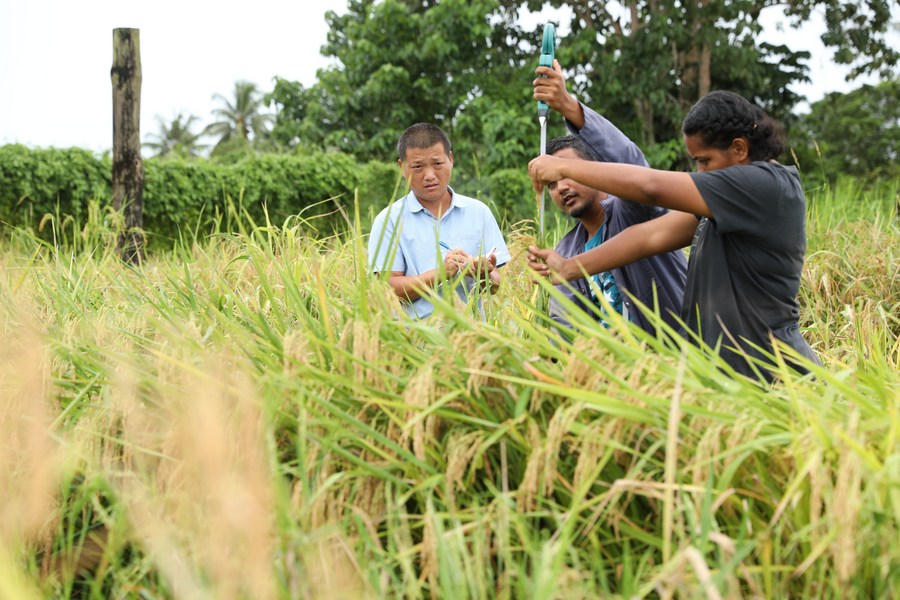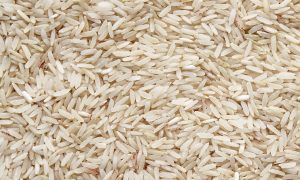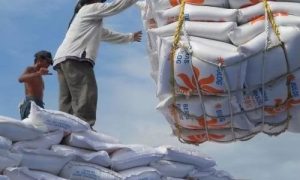Digital transformation is the new buzz on rice fields

ĐỒNG THÁP — The daily routine of farmers has undergone a complete transformation, shifting from traditional methods of observing nature to relying on smartphones as an essential tool. The Mekong Delta is witnessing a continuous digital transformation revolution in agriculture, unfolding every day and every hour.
Amid the radiant sun and expansive rice fields nearing harvest season, farmer Nguyễn Văn Khanh greeted us warmly, on his sun-darkened face a bright smile.
As he led us to see the rice fields, he pointed to the unmanned aerial vehicle flying above and said: “I bought this T10 myself, then hired someone to operate it. The machine is spraying organic fertiliser to make the grains firm. Modern rice farming is different now, not like before, with many mechanical processes to take care of.”
Khanh, a prominent farmer in the “land of pink lotus” Đồng Tháp, has gained recognition for his achievements growing Japanese rice varieties in Tam Nông District. With a rice production area spanning 120 hectares, he is committed to adhering to the VietGAP standard. This involves reducing pesticide usage, producing high-quality and safe rice, and mitigating the environmental impact of fertilisers and chemicals. To achieve this goal, he utilises unmanned aerial vehicles and a range of other mechanical tools.
Khanh said: “Agricultural production according to VietGAP standards is different from traditional agriculture that uses a lot of fertiliser and chemicals. Cultivating three rice crops a year with that amount of fertiliser and chemicals will heavily pollute water sources and land. Applying VietGAP standards to the rice production process will reduce productivity, but with large-scale production, closed processes, and the use of modern technology in care, production costs will decrease, while product prices will be higher.”
Recognising the pivotal role of modern technology in rice cultivation, Khanh has invested in a range of advanced machinery, including unmanned aerial vehicles, electric pumps, ploughs, cultivators, combine harvesters, and excavators. Additionally, he employs smart sensor systems in the fields to monitor various factors such as water quality, pest presence and weather changes, enabling him to devise solutions proactively through his smartphone. With the aid of modern technology, Khanh efficiently manages his 120-hectare rice fields with just 30 workers.
In January 2024, Khanh expanded his commitment to sustainable agriculture by dedicating 32 hectares of his rice fields to the project “Transforming the rice value chain in response to climate change and sustainable development in the Mekong Delta.”
This initiative, backed by a A$17 million (US$10.8 million) investment from the Australian Government and executed by the Netherlands Development Organisation in collaboration with agricultural sectors in An Giang, Đồng Tháp and Kiên Giang provinces, aims to convert 200,000 hectares of rice to sustainable production in over six consecutive seasons from 2023 to 2028. This endeavour seeks to reduce greenhouse gas emissions and safeguard the environment.
Assessing the current landscape of rice production in Tam Nông District, Lâm Trọng Nghĩa, deputy director of the Tam Nông Agricultural Services Centre, notes that farmers face challenges in determining rice selling prices and reducing production costs. Despite potential limitations on productivity compared to traditional methods, cost reductions translate to increased profits. In regions like Đồng Tháp Province, where unpredictable weather disrupts the annual cycle, advanced technical solutions and modern technology enhance the resilience of rice plants to climate change, ensuring consistent productivity and quality.
According to Trần Thu Hà, director of the project “Transforming the rice value chain in response to climate change and sustainable development in the Mekong Delta”, the project has mobilised 11 reputable companies in the rice industry to collaborate with farmers and cooperatives in localities. These companies have brought excellent technology packages to ensure that farmers receive at least 30 per cent of the profits from rice production when implementing purchase contracts. The products can participate in the premium rice segment; and when carbon credits are sold, companies will also share profits with farmers.
“In the first phase, more than 8,000 hectares of rice have been registered to participate in the project. The activities will lay the foundation for companies and farmers to link themselves and share profits. The project has proposed a measurement reporting, and verification system for greenhouse gas emissions reduction (MRV), recognised by the United Nations Framework Convention on Climate Change, which can be applied on a large scale. Carbon credits from the project are not only traded at the project or national level, but can also enter the international voluntary carbon market,” Hà added.
According to the implementation orientation of the project “Sustainable development of one million hectares of low-emission, high-quality rice cultivation, linked to green growth in the Mekong Delta by 2030”, Tam Nông District has registered about 4,900 hectares of rice to participate in the project by the end of 2023, 12,000 hectares in 2025, and over 29,000 hectares in 2030 – equivalent to the entire rice area of the district. The expansion of rice cultivation area to reduce emissions is being implemented more urgently than ever.
Nghĩa from the Tam Nông Agricultural Services Centre highlighted that farmers in Tam Nông, already adept at modern cultivation techniques and climate change adaptation, stand to benefit greatly from specific guidance, which could bolster the local agricultural sector. As awareness grows regarding the significance of modern technology in rice production, there’s a gradual shift towards organic farming and the adoption of scientific methods, potentially becoming a widespread movement in the region.
Source Link: https://vietnamnews.vn/society/1654354/digital-transformation-is-the-new-buzz-on-rice-fields.html

















